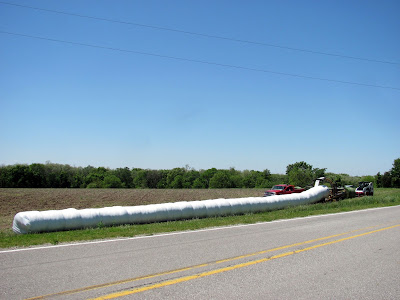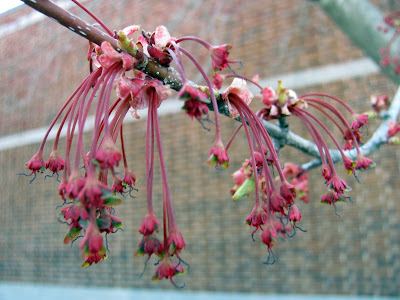bright red bee eater
bashing its body against
its own reflection
Driving home this afternoon, I admire a "blue cloud," a patch of open sky to the southeast, hoping for signs of letup in the rain. But when I look the other direction, the sky is covered by a massive dark gray eminence, moving fast. I barely make it home before the tumultuous 70 mph wind and torrential downpour. It blows in and blows out quickly, taking down more trees (including a big willow on a little island on a neighbor's pond). Soon the sun comes out and every rain-soaked plant glistens.
Then a mysterious bright red bird appears under the bird feeder and begins bashing itself against the sun porch windows, over and over and over. I've seen this behavior with male birds before during breeding season. He's obviously mistaking his reflection in the glass for a rival male, which he's trying to drive away from his nesting mate.
I've never seen a totally all red bird like this before. He doesn't have a crest, so he's not a Cardinal. I go outside to try to shoo him away from the windows. He's so intent on his mission that he lets me get really close so I take a few photos, but he just keeps moving from window to window as I follow him around the house. Once, he flies off to the cherry tree and returns to the fence railing with a green grub, which he quickly consumes, then back to attacking his imagined rival. Later, he catches what looks like a wasp, then beats and rubs the insect on the fence railing before gulping it down. In between bashing bouts, the "red and all red" bird sits on a branch and makes a sound like "Chi up!," which must be his mating call.
I'm wondering where his mate is when I suddenly I recall seeing an unfamiliar olive brown bird a few days ago hopping around our Summer Sweet bush. She was pecking at last year's empty seed pods, then finally breaking one off and flying away with it. I figured she was on a nest-building project and now I think she must be the female Summer Tanager.
I'm wondering where his mate is when I suddenly I recall seeing an unfamiliar olive brown bird a few days ago hopping around our Summer Sweet bush. She was pecking at last year's empty seed pods, then finally breaking one off and flying away with it. I figured she was on a nest-building project and now I think she must be the female Summer Tanager.
I go inside to call my bird expert friend for advice. She thinks it might be a Scarlet Tanager or a Summer Tanager and suggests taping cardboard to the windows to block the reflection. That would be a lot of cardboard and the windows are wet. John tries plastering the windows with wet leaves, but the persistent bird can still see its reflection, so all we can do is wait for it to get dark.
When I do an internet search, I discover that our crazy bird is a Summer Tanager. Southern Iowa is its northern-most breeding grounds. This bird is special because it's the only all red bird, and also because it specializes in eating wasps and bees. The bird has mastered the technique of killing the insect by bashing it against a branch (or fence railing) and, even more amazing, how to rub the stinger off before swallowing its catch. Well, we'd be delighted to have our own private wasp eater, but our bee keeper neighbor is not going to be happy about having him around!
The next day, Red is back, but he's progressed from body flinging to body bobbing. He perches on top of the bench outside the sun porch, facing the window, and bobs his body up and down over and over. And today, no sign of him. Perhaps he's busy catching bugs for baby birds.
The next day, Red is back, but he's progressed from body flinging to body bobbing. He perches on top of the bench outside the sun porch, facing the window, and bobs his body up and down over and over. And today, no sign of him. Perhaps he's busy catching bugs for baby birds.


































